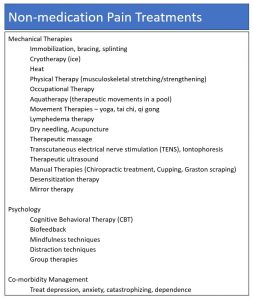4 general points to consider when treating acute or chronic pain with opioids:
- In opioid-naïve patients, treatment by a clinician who prescribes opioids more frequently than their peers is strongly correlated with subsequent long-term opioid use in patients.
- Treatment of acute severe pain with opioids may be appropriate. Follow the new TN Together law (updated as of July, 2019) when treating acute pain with opioids by limiting the duration to 3 days.
- Many chronic diseases will not improve, or can be made worse, by chronic opioids. Examples include some types of neuropathic pain, headaches, and central pain disorders like fibromyalgia. Follow the TN Chronic Pain Guidelines and the CDC Guidelines when treating chronic pain with opioids.
- Your medical judgement is key. When treating pain, consider and try non-medication options and non-opioid pain medications. Target the treatment to the type of pain and anticipated duration of pain for the best outcome. Below are simplified reference tables that demonstrate the types of pain and non-opioid treatments that can be considered.

References:
- Jones JD, Mogali S, Comer SD. Polydrug abuse: a review of opioid and benzodiazepine combination use. Drug Alcohol Depend. 2012 Sep 1;125(1-2):8-18
- Manchikanti L, Kaye AM, Knezevic NN, et al. Responsible, Safe, and Effective Prescription of Opioids for Chronic Non-Cancer Pain: American Society of Interventional Pain Physicians (ASIPP) Guidelines. Pain Physician.2017 Feb; 20(2S):S3-S92
- Scott MJ, McEvoy MD, Gordan DB, et al. American Society for Enhanced Recovery (ASER) and Perioperative Quality Initiative (POQI) joint consensus statement on optimal analgesia within an enhanced recovery pathway for colorectal surgery: Part 2 – From PACU to the Transition Home. Perioper Med, 2017; Apr 13;6:7
- Wachman EM, Schiff DM, Silverstein M. Neonatal Abstinence Syndrome: Advances in Diagnosis and Treatment. JAMA. 2018 Apr 3;319(13):1362-1374.
- 2018 TN Together Opioid Prescribing Law (amended July 1, 2019)
- TN Chronic Pain Guidelines and the CDC Guidelines


